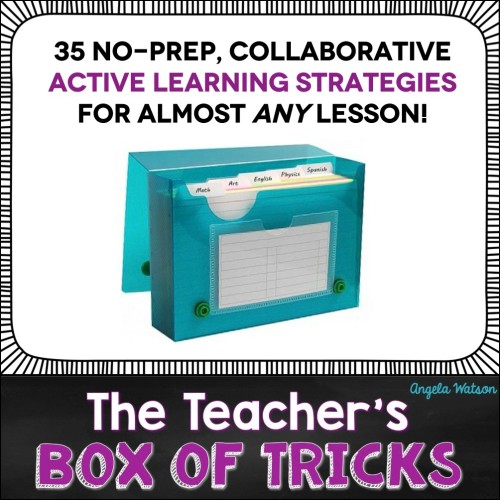Every teacher needs more class time. And every year, it seems like there’s more and more content that needs to be covered and less time to teach it in, due to excessive testing and other distractions.
Fortunately, there are some easy ways you can create more time for teaching. There are lots of things happening in our classrooms that either waste time or just make lessons take longer than they need to. If you struggle with lesson planning because you just don’t have time to teach everything you’re supposed to, these easy tips and productivity hacks will help you maximize every moment with students.

Want to listen instead of read?
Use the podcast player above to play or download this episode.
1. Look for unnecessary tasks you give kids simply because they’re traditional.
For example, we all know that kids memorize words for a spelling test but that learning rarely transfers over to their actual writing. If you’re not required to give spelling tests, ask yourself whether there is a better use for the 10-20 minutes of class time you use for that each week.
2. Cut out daily routines that waste time.
Do you spend five minutes of class time taking attendance? 10 minutes having kids copy their homework assignments? 20 minutes to have students pack up and prepare for dismissal? That’s 35 minutes a day that could probably be condensed into about 10 or less. Check out my tips for arrival and dismissal routines for ideas on how to streamline these systems.
3. Spend less time on bathroom/water fountain trips.
Many elementary teachers sacrifice 10-20 minutes of instructional time a day to allow students to take bathroom and water fountain breaks, which really aren’t a “break” for students at all because they have to stand still and be quiet in the hallway. Try to streamline your procedures for bathroom/water fountain breaks as much as possible, and use a free site like GoNoodle to give kids an actual “brain break” and chance to move around.

4. Minimize class time that’s spent color-coding and illustrating.
There’s nothing wrong with allowing kids to color code their notes, draw graphic organizers, decorate projects, and so on — it just takes up a tremendous amount of class time, especially for artistic students and those who are perfectionistic.
- Teach students to write FIRST, then draw afterwards if they have time.
- Give students explicit permission to turn in illustrations that aren’t “perfect” and emphasize that students are not being graded on their drawing abilities.
- Model how to draw illustrations quickly, demonstrating how it’s not necessary to spend more than 30 seconds making a science diagram (lines don’t have to be made perfectly straight with a ruler) or illustrating a math problem (drawing quick circles to represent objects instead of the actual objects, for example.)
- Have students do coloring/decorating for projects at home so they can spend as much or as little time as they’d like.
5. Give classwork for homework and vice versa.
Traditionally, we teach material in class and then have students practice it and/or create related projects at home. Flip that model by having students read content or watch videos on it for homework — you’ll have far more class time for guided practice and projects, and you’ll be there to help students when they get stuck (a luxury they don’t have at home!).
You don’t have to follow a full flipped classroom model to use this strategy. Just think about the tasks that you’re currently giving students to complete independently in class, and try giving one of them for homework instead. The next day, have students do a follow-up or practice activity in class.
Eventually, you may want to try creating a screencast or video of you teaching a mini-lesson. It doesn’t have to be anything fancy, and you don’t even have to show your face (focus your phone/video camera on your hands and the paper/materials you’re demonstrating). Students can watch the lesson for homework, and you can re-use it from year to year. The videos are also super helpful for students who are absent and for helping parents understand the strategies you want students to use.
Here’s an overview and some research about flipped learning. Or, check out the Flipped Learning Community for more support and ideas.
6. Have students give presentations in small groups instead of the whole class.
Nothing drains away class time more than two dozen (or more) student presentations. And what’s the point when kids tend to tune out and stop learning after the first few? So, try having students present in groups of 4-5 instead. They still get all the benefits of learning from their peers but in a much more condensed period of time.

7. Have students write fewer complete essays and give them fewer problems to solve.
If you never have enough time in class for students to practice writing under your guidance or with a peer, consider having them write a shorter amount of text so you can assess just the aspect of their work you’re focusing on. For example, if you’ve modeled how to write a strong introductory paragraph, ask students to just write the introduction rather than a complete essay.
Similarly, if you’re looking for strong word choice or voice in student writing, there’s no need for kids to write 1,000 words. Make the assignment shorter so students can focus more on the skill rather than trying to quickly finish the entire essay before time is up.
Similarly, it’s tempting to assign students a full page of problems to solve or questions to answer–after all, everything is right there on the page already, right? But chances are good that you can tell after 10 problems whether a student “gets it.” So why use up more class time and wear students out by assigning the whole page?
I used to allow students to stop after 10 problems and show them to me; if they got them all right, they’d be allowed to work on something else. This motivated them to pay attention to accuracy rather than just rush to complete the page. If they didn’t get all 10 right, I’d address the misconception and have them try 5 more.
I’ve also allowed students to do just the even or odd numbers on a page, or to choose any 15 problems on the page they’d like. This tiny bit of control has a surprising effect on student motivation, takes up less class time, and creates less grading for the teacher.
8. Avoid making students wait until everyone in class is done with a task.
This is probably the #1 waster of class time that I see as an instructional coach. A teacher may give a task that some students finish in three minutes and most of the class can finish in five … but the teacher doesn’t review it or move on to the next task until eight or nine minutes have passed because s/he wants everyone to be done.
This means that the majority of the class now has several minutes with nothing to do … which results in off-task behavior … which distracts the kids who are supposed to be still working … which prolongs the amount of time it takes for those kids to finish … and now a fifth of the class period is gone and students have barely done any work.
Instead, try using a timer and setting it for the amount of time that an average ability student can complete the task in. Challenge everyone to be done in that amount of time. When the timer goes off, tell kids it’s okay if they’re not done, and start reviewing the task. They can fill in whatever information they didn’t get as you review it. Or, set the timer for as long as it will take for a slightly below-grade-level student to complete the task, and add an extension activity (“If you finish before the timer goes off, explain your thinking in writing/create your own problem at the bottom of the page/etc.”).

9. Don’t have the whole class do the same activity at the same time.
You can avoid having students wait around unnecessarily for slow finishers if students are working at their own pace. Small groups, centers, workstations, and other rotations can help. Project-based learning does, too.
10. Use many of the same learning activities over and over
Introducing a new activity to your class takes up more class time than doing things in a familiar way. It’s important to repeat the same activities enough times that students know what to do automatically and you don’t have to model, practice, and reinforce your expectations every time. And if something is really engaging and enjoyable for kids, they won’t mind doing something similar again later.
When you introduce a new form of learning or activity to students, repeat it again the following day or later in the week. Then do it again the next week. Take a break for a week or so, then do it again. At this point, it should be a regular part of the students’ repertoire and very little class time (if any) should be spent on explaining what to do and getting kids started. You can gradually add new activities so that you have a large amount in rotation and kids don’t get bored.
You really don’t need to reinvent the wheel and spend hours looking for interesting ways to teach every lesson. Like other experienced teachers, I’ve taught the same concepts and skills to students so many times that I’ve developed a huge repertoire of activities that I can build into my instructional time.
I have activities that provide more scaffolding if the kids didn’t really seem to understand the lesson and activities that will extend student learning if what I taught was too easy. I have activities that will take a long time if my lesson ends early and activities that can be done quickly if my lesson takes too long.
I’ve refined this mental list with hundreds of students over the course of the last 15 years. These are my go-to strategies that I’ve used over and over when I was in the classroom and still today as an instructional coach.

I recently took the time to write these strategies out for other teachers. I’m calling it The Teacher’s Box of Tricks: It’s a set of go-to active learning strategies that can be implemented (and adapted) with no prep.
10 of the ideas will help you turn worksheets into engaging collaborative activities. So instead of killing students with another boring test prep activity, you can turn it into a collaborative, higher level thinking activity right on the spot.
Another 25 activities are worksheet-free and simply provide an easy way for kids to practice the skills you’ve just taught them (so you can ditch the worksheets and traditional pencil-and-paper activities altogether).
The ideas in The Teacher’s Box of Tricks are adaptable for ANY subject area, ANY grade level 3rd and up (modifiable for students who aren’t reading/writing independently yet), and require no special materials: You’ll need only basic classroom supplies, like scratch paper and pencils. They allow you to make worksheets more meaningful OR replace them completely with active learning strategies.
I’ve created this in a list format AND sized to fit a 3×5 index card file box to create a literal box of tricks. Write your own ideas down on index cards and keep adding to your box of tricks over the years!
Stop wasting time on things that aren’t serving you or your students well. Figure out what’s unnecessary in your classroom so you have time for what matters most.
Only had time to skim this article? Click the podcast player above to listen instead!
This post is based on the latest episode of my weekly podcast, Angela Watson’s Truth for Teachers. A podcast is like a free talk radio show you can listen to online, or download and take with you wherever you go. I release a new 10-15 minute episode each Sunday and feature it here on the blog to help you get energized and motivated for the week ahead. I’d love to hear your thoughts below in the comment section!
The Truth for Teachers Podcast
Our weekly audio podcast is one of the top K-12 broadcasts in the world, featuring our writers collective and tons of practical, energizing ideas. Support our work by subscribing in your favorite podcast app–everything is free!
Explore all podcast episodes
Angela Watson
Founder and Writer
Discussion
Leave a Reply
OR

Join our
community
of educators
If you are a teacher who is interested in contributing to the Truth for Teachers website, please click here for more information.



















Love this– especially the concept of having a student complete a certain number of problems and if they’re correct, move on. If not, address the issue and assign a few more from the same handout. It’s about giving each child what he or she needs, and it doesn’t involve creating a bunch of different activities!
#5 and #6 will stretch me for sure. Thank you for the strategies! Life long learning